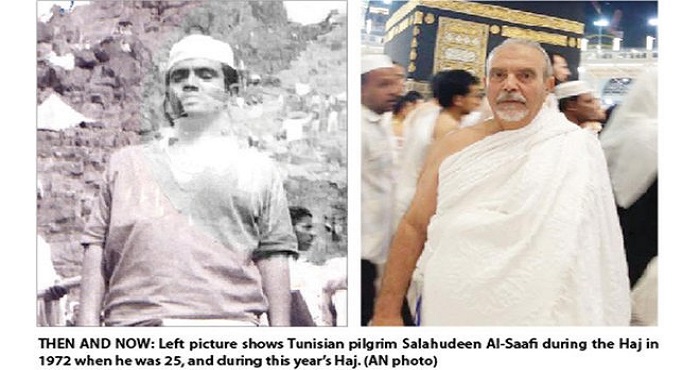“From a journey full of hardships and difficulties to a place of worship covered with luxury.”
That is how Tunisian pilgrim Salahudeen Al-Saafi described his two journeys to Haj within a time gap of 44 years.
Al-Saafi is probably one of the very few people who documented his past and present pilgrimages from the day he left his country until the day he returned after having performed Haj.
Al-Saafi said performing the pilgrimage in the past entailed quite some suffering and lots of exhaustion, whether for land travelers, who had to cross a variety of natural terrain, including deserts, and spent long days, maybe even months to arrive in Makkah, or for seafarers who had to put up with the whims of the sea, no easy endeavor in the 1970s where ships in Tunisia were quite primitive.
He said he first embarked on Haj in 1972, at the age of 25. His journey began at Halq Al-Wadi Port in Tunisia on board the ship Al-Habib, the sole ship owned by Tunisia at the time.The only way for Tunisians to perform Haj was to arrive in Jeddah by sea.
On board the ship, religious lessons were delivered during the 10-day journey to people eager to see the Holy Kaaba and the Grand Mosque and enjoy the holy sites.
Upon arrival in Jeddah, the pilgrims were quarantined for health reasons in an area called Al-Tour. Later, after making sure they were free from infectious diseases, they would be sent to the holy sites in a process that took between 3 and 10 days, he said.
After the arrival in Jeddah, a new journey would begin for pilgrims to Makkah, to perform Tawaf Al-Qudoom ritual.
The first stop would be at an area called Um Al-Salam, where pilgrims used to perform prayers and rest in a spiritual atmosphere.
Services provided to pilgrims at the time were simple; every pilgrim had to depend on himself for food and water, and there were only a few scattered groceries on the way where pilgrim convoys passed, he said.
The roads leading to Makkah were desert at the time, simple and narrow.
Pilgrims were divided into sections based on their financial situation. Some hired a simple car to arrive in Makkah, others took buses, while others moved on camels.
After getting into ihram at meeqat, they performed Tawaf Al-Qudum, kissed the Kaaba, if possible, then moved toward Safa to begin the Safa and Marwa journey. There, the healthy pilgrims used to carry sick pilgrims in wooden boxes that looked like grain containers, he said.
On the 9th day of Dul Hijjah, the pilgrims moved to Mount Arafat in heavy lorries to perform the biggest Haj ritual.
“We used to put our luggage on the roof of the car and then sit on it with our hearts eager to see Mount Arafat and touch the soil of this holy site,” he said.
In the 1970s, there was no official coordination on areas accommodating pilgrims; each one erected his tent by himself, he said. Pilgrims from the same country used to erect their tents in one area, and from there they would move to Muzdalifah and then Mina.
The majority of pilgrims moved on foot at the time. Now they move in comfortable, air-conditioned buses, as well as by train, he said.
After throwing stones (at Jamrat), pilgrims would move to the slaughterhouse to select the sacrificial animal and witness the slaughtering process, he said. Finishing the Jamrat, they would move to the Grand Mosque to perform tawaf (circumambulation).
At the time, Zamzam water was not served as it is now; pilgrims used to go near the well and drink it, while some good men would fill some containers and pass them to the pilgrims, he said.
In the past, pilgrims had to carry food, water and other supplies to meet their needs for days and months on the road. Nowadays, food, drinks and medical treatment are available everywhere a pilgrim goes, he said.
Al-Saafi finds a big difference between the past and present pilgrimage process.
The blessed march drawn up by King Abdul Aziz and followed by his noble sons, focused on the security and comfort of Hajis through mega expansions of the Two Holy Mosques, development projects in Jamrat, the Mashair train, the expansion of the Masaa and the expansion of the Prophet’s Mosque, he said.
All these changes have made the Haj journey easier and more enjoyable and, more importantly, enables pilgrims to put aside any worries and focus on the rituals, he said.
“Allah Almighty gave the Kingdom brave leaders who broke stones, paved ways and sacrificed themselves to serve the House of Allah and who deserve to be called Custodians of the Two Holy Mosques,” he said.






 WhatsApp us
WhatsApp us 

